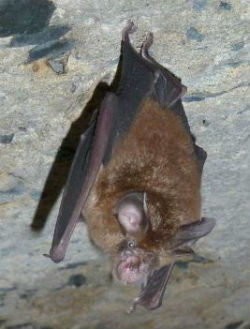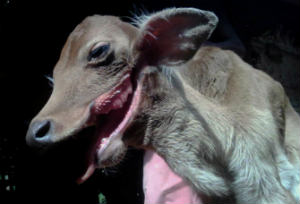Horseshoe Bat Hybrids
Family Rhinolophidae
Mammalian Hybrids
EUGENE M. MCCARTHY, PHD GENETICS
|
|
Hipposideros sp. [Leaf-nosed Bats]
× Triaenops sp. [Trident Bats] Dobson (1878, p. 126) says the Orange Leaf-nosed Bat (Rhinonicteris aurantia) is “intermediate between Triaenops and Phyllorhina, though it agrees more closely with the former than with the latter.” Phyllorhina is a synonym of Hipposideros, so Dobson’s statement suggests R. aurantia, which is the only member of its genus, as a product of this cross, that is, that it is a product of hybridization between some member of Hipposideros and some member of Triaenops. Explaining this intermediacy, he says R. aurantia has its
However, R. aurantia is a resident of northern Australia, and the genus Triaenops is restricted to the Middle East, Africa, Madagascar and adjacent islands. The closest documented occurrence of Triaenops to Australia is Triaenops persicus in Pakistan. And yet, a theory can be proposed to account for the origin of aurantia: If aurantia is in fact of hybrid origin, there must anciently have been a pure, Triaenops-like population present in northern Australia that has been genetically altered over time by hybridization with some member(s) of the genus Hipposideros (perhaps Hipposideros ater or H. stenotis). Under this scenario, aurantia would be a genetically composite population showing the influence of both Hipposideros and Triaenops ancestors, which would account for its composite, intermediate traits.
Hipposideros bicolor [Bicolored Leaf-nosed Bat]
× Hipposideros fulvus [Fulvus Leaf-nosed Bat] ENHI(southeast Asia). As currently defined by the IUCN, these bats have disjunct ranges, with fulvus residing in India, Sri Lanka, and Pakistan, while bicolor is a resident of southeast Asia and Indonesia. “Between these, however,”says Dobson (1878, p. 149), “so many intermediate forms are found that it appears quite impossible to recognise more than one species.” So bicolor and fulvus are separated by populations that are geographically and morphologically intermediate, and which can therefore be viewed as the constituents of a wide hybrid zone.
Hipposideros fulvus [Fulvus Leaf-nosed Bat] See: Hipposideros bicolor.
Rhinolophus celebensis [Sulawesi Horseshoe Bat]
× Rhinolophus virgo (♀) [Yellow-faced Horseshoe Bat] ENHI. The type specimen of R. virgo was taken in the southern part of Camarinas, on Luzon (Philippines), while R. celebensis is described from Sulawesi and the northern Moluccas. Specimens from Negros Island are geographically and morphologically intermediate and are thus PHPs of this cross. Intermediates also occur on Palawan. Corbet and Hill 1992 (p. 102); Sanborn 1952.
Rhinolophus megaphyllus [Eastern Horseshoe Bat]
× Rhinolophus philippinensis (♀) [Large-eared Horseshoe Bat] ENHI(northeastern Australia). CON: northern Queensland and New Guinea. Morphological intermediates occur on Cape York Peninsula, which is geographically intermediate. They are thus PHPs of this cross. Probable hybrids have been treated as races under the names maros and robertsi. In addition, Cooper et al. (p. 214) say morphological, allozyme and mtDNA are consistent with two hypotheses, either that the intermediates represent (1) “a distinct species that has only recently evolved in Australia either from a R. philippinensis-like common ancestor or by hybridisation between R. philippinensis and R. megaphyllus” or (2) “a hybrid between R. megaphyllus and R. philippinensis.” These probable hybrids are found only where R. megaphyllus and R. philippinensis occur together and are intermediate in size and shape, though their noseleafs are more similar to those of R. philippinensis. Their echo location call frequency is also intermediate (~40 kHz, vs. 66 kHz in R. megaphyllus and 28 kHz R. philippinensis). The mtDNA data indicates the female parent is R. philippinensis, the larger of the two parental types. Cooper et al. 1998.
Rhinolophus philippinensis [Large-eared Horseshoe Bat]
Rhinolophus virgo [Yellow-faced Horseshoe Bat]
Rhinonicteris aurantia [Orange Leaf-nosed Bat] See: Hipposideros sp. × Triaenops sp.
By the same author: Handbook of Avian Hybrids of the World, Oxford University Press (2006).
Most shared on Macroevolution.net:
Human Origins: Are we hybrids?
On the Origins of New Forms of Life
Mammalian Hybrids
Cat-rabbit Hybrids: Fact or fiction?
Famous Biologists
Dog-cow Hybrids
Georges Cuvier: A Biography
Prothero: A Rebuttal
Branches of Biology
Dog-fox Hybrids

 A dog-cow hybrid?
A dog-cow hybrid?